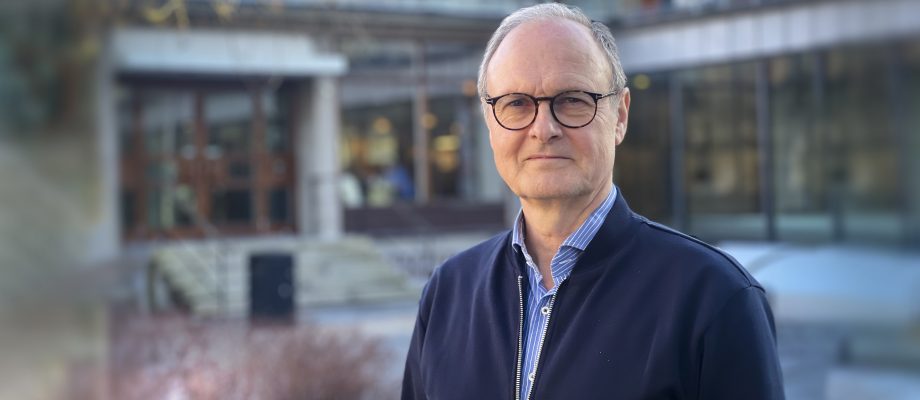LEADERSHIP ROLE. Student throughput in our educational programs and the development of our educational facilities are two future-focused issues within education. Meet Gudmundur Johannsson, who has now taken on the role of vice dean.

As a professor at the University of Gothenburg, Gudmundur Johannsson is active in endocrinological research and education. He focuses on pituitary and adrenal diseases, encompassing various, often rare, conditions. In Gothenburg, several groups in the field conduct successful research in close collaboration with Sahlgrenska University Hospital. This research is also frequently recognized internationally.
Gudmundur also practices clinically as a senior physician at Sahlgrenska University Hospital.
“I enjoy solving problems, and that was a major reason I chose my clinical specialty. The more complex the challenges, the better”, says Gudmundur Johannsson, noting that the field of education is in the same spirit:
“The Sahlgrenska Academy faces several challenges, where many staff in our educational programs and our teaching staff need to contribute to solutions. Here, the clinical context is also important, where both Sahlgrenska and the region must be part of the discussions. It feels stimulating to tackle these issues together.”
Clinic, research, and education

Current: New Vice Dean for Education from January 1, 2024.
Age: 63
Resides: In a house outside Halmstad and an apartment in Gothenburg
Free time: Enjoys walks in nature with his wife and dog
Trivia: Gudmundur is one of the contributors behind the drug Plenadren, from clinical trials to approval by the European Medicines Agency. Since its registration, he has no financial interests in the drug.
His background includes medical education at the University of Iceland, followed by clinical service and research at several hospitals in Western Sweden. He defended his thesis in 1997 on the treatment with growth hormone replacement for adults. In parallel, he has held all possible roles in education: from teacher and supervisor to member and chairman of various bodies driving development in education.
Until recently, he was the vice head of education at the Department of Medicine; a role that prepared him well for his current role as vice dean. As vice head, he was also vice chairman of the Education Council for several years, where he has now become chairman in his capacity as vice dean.
“A new context for me is that I have now become a member of the university’s education board. So far, I have attended one of the board’s meetings. Sahlgrenska Academy is part of a large and broad university, and I look forward to learning more about education issues from a GU perspective”, says Gudmundur.
Influential factors
One of the most current education issues at the faculty is the throughput of students in our programs. What can we do to ensure that more of the students admitted to our programs also complete them? For the faculty, the issue has a concrete economic dimension, as we only get paid for the students who graduate. At the societal level, throughput is also a concern, as we educate in competencies and professions that future healthcare needs.
“This is a complicated issue with different layers, where many aspects are beyond our control. To start, we will conduct a survey of the factors that are influencable. We want to identify the efforts that we can make to improve throughput”, says Gudmundur Johannsson.
Part of the groundwork that has been initiated is benchmarking, to learn from experiences at other universities. In addition to investigating factors related to throughput for other programs within GU, our conditions are also compared with those for the same professional programs at other universities.
“The experts in their respective fields are in our educational programs. Program managers, course coordinators, and other teachers who know the challenges and conditions of their education. They are key figures in the work to identify the efforts that we can make”, says Gudmundur Johannsson.
Here, he also emphasizes the importance of the Sahlgrenska Academy’s and the University of Gothenburg’s brand in education.
“We want to attract the best students possible, that they choose to come here. Then it is important that those who apply know that we are an institution with high standards in education and research.”
Choice of path for teaching
Another future issue for the faculty is the teaching facilities. Here, we need to determine the direction education will take. How much, for example, will be given digitally or in hybrid form, and how much campus teaching do we and our students want? The future direction requires internal dialogue, notes Gudmundur Johannsson.

“We will eventually move from Hälsovetarbacken, and thus also from the current clinical training center KTC. In the design of Sahlgrenska Life, we have planned a new common Skills Center together with the Västra Götaland Region, which both we and the region will use”, says Gudmundur.
Currently, the region is preparing its implementation decisions for Sahlgrenska Life and evaluating the possibilities of erecting all three buildings covered by the project. The local issues will naturally be the main focus for the vice dean who has not yet been appointed, for both facilities and infrastructure.
Complete leadership team
The leadership team in place has started its collaborative work. In addition to Dean Jenny Nyström, Pro Dean Magnus Simrén, and Vice Dean Gudmundur Johannsson, it also includes Mats Brännström (Vice Dean for Research), Mia Ericson (Vice Dean for Doctoral Education), and Ewa-Lena Bratt (Vice Dean for Internationalization and Collaboration).
“It’s fun to be part of a complete leadership team that can take the big approach to the business, and where all kinds of questions can be raised. I have a very positive feeling about this leadership team. There are good opportunities for us to have an open discussion and many constructive discussions”, concludes Gudmundur.
BY: ELIN LINDSTRÖM











